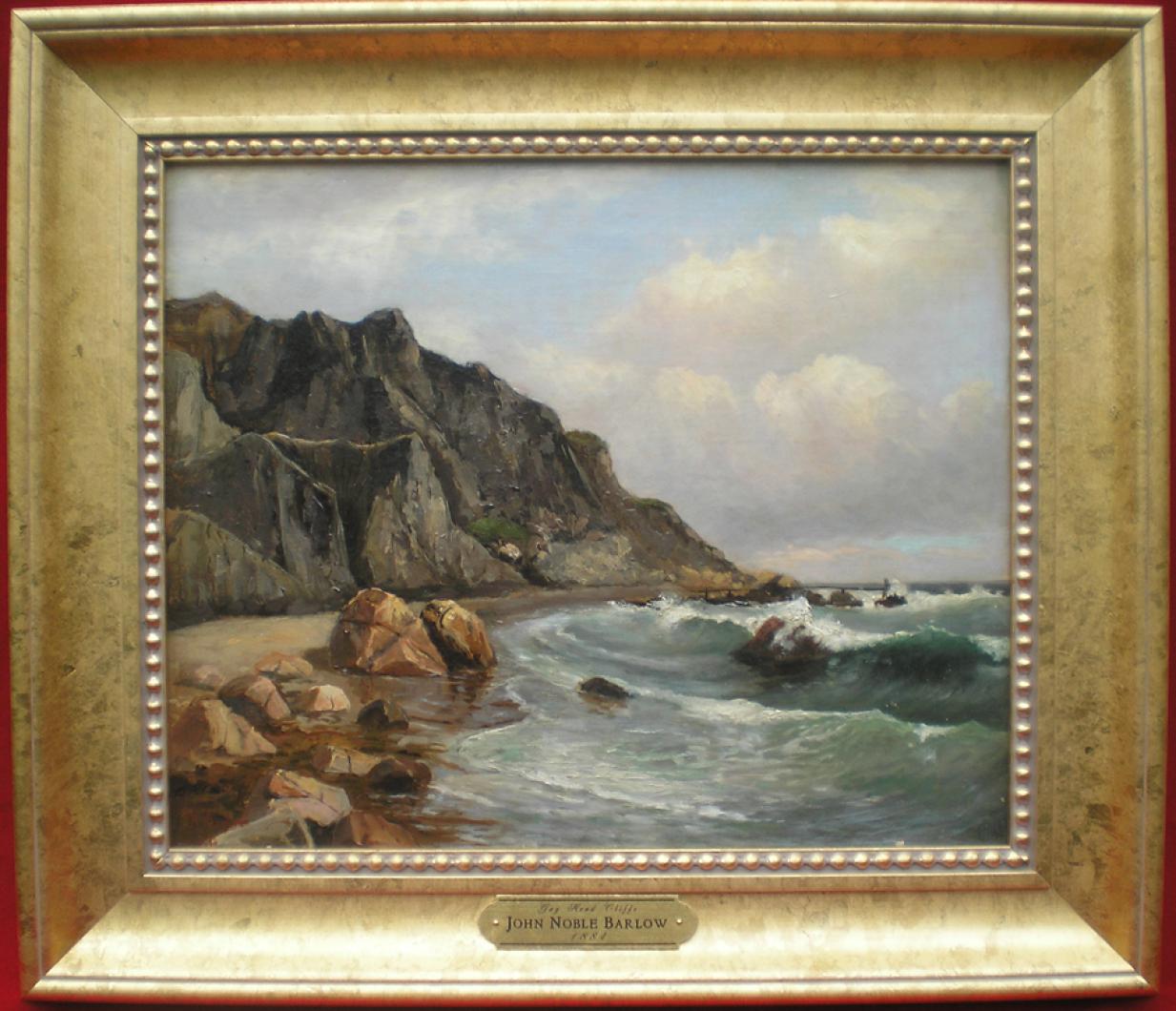A beautiful, small painting of the Gay Head Cliffs has returned to the Vineyard for a short visit, possibly the first time since it was painted 125 years ago. The painting by John Noble Barlow depicts colorful cliffs and a turbulent dark sea. The waves are translucent in the late afternoon sun. It is an impressive oil painting that presents an opportunity for an amazing tale.
Contained in a wide gold-leaf frame, the painting was hung at the West Tisbury Free Public Library on Tuesday and it will remain there in the main room through the month of July.
Chris Ratcliffe, of Cumberland, R.I., purchased the painting 15 years ago at an art auction in Boston. When he first saw it, the painting was dirty, sat on a table, in an area he described as crowded with other paintings.
Mr. Ratcliffe owns an advertising agency in Providence called Triple M Productions and for many years he has collected art. He said he specializes in purchasing paintings by artists who were members of the Providence Art Club, the second oldest art club in the country, founded in 1880.
Mr. Ratcliffe said he likes to look for 19th century paintings. John Noble Barlow exhibited his work at the club from 1883 to 1887. Mr. Barlow was celebrated as a painter of seascapes and landscapes. Three of his paintings hang at the Rhode Island School of Design Museum.
The painting Mr. Ratcliffe possesses has no information on it as to where it was done. He had it cleaned and reframed, and hung the painting above a sofa in the family living room.
Though Mr. Ratcliffe and his wife, Melinda, have been coming to the Vineyard for 20 summers, the painting wasn’t first thought to be a Gay Head painting.
“I started researching some of my paintings. At first I thought it was Monhegan Bluffs on Block Island,” Mr. Ratcliffe said. He e-mailed a picture of the painting to the historical society in Rhode Island without result.
Maybe it was Gay Head, he thought. But there was in the painting a curiosity amid the high seas and the dangerous rocks: a pier. Gay Head was not a first choice, because Gay Head doesn’t have piers today.
Still, Mr. Ratcliffe took his inquiry to the Vineyard. A small story about his quest to identify the site in the painting appeared in the Vineyard Gazette the day after Christmas, 2008.
Joanne Polner, a reader of the Gazette and a resident of Franklin Lakes, N.J., and Chilmark, responded to the article and offered to help. She informed the art collector of the work of a 19th century photographer who had taken pictures of the Gay Head Cliffs. Mr. Ratcliffe referred to her as integral in helping with the research. She, too, was at the West Tisbury library on Tuesday.
“The main part of the discovery came from a book called New England Views, the Photography of Baldwin Coolidge,” Mr. Ratcliffe said. The photographs spanned 1845 to 1928. There was a series of photographs depicting the Gay Head Cliffs and back in the 1800s that showed a pier at the foot of the cliffs. One of the Baldwin Coolidge’s photographs in the possession of the Historic New England Museum in Boston showed the specific pier existing at the Gay Head cliffs site.
Doing additional research into 1884, Mr. Ratcliffe found the story of the tragic maritime disaster, the sinking of the steamer City of Columbus off Devil’s Bridge at Gay Head on Jan. 18, 1884. The world found out about the cliffs that winter, when the story was published around the globe about the loss of lives in the bitter cold night.
While Mr. Ratcliffe can’t know for certain, he believes the sinking of the City of Columbus inspired many to visit the site and one of them was the artist. The pier was obviously an important part of the story.
To get even closer to the painting’s story, in April Mr. Ratcliffe returned to the Vineyard and with his 11-year-old daughter Hannah and visited the site of the painting. The Ratcliffes have three daughters. “We came on school vacation week. We wanted to find the exact position where Barlow had stood when he did his painting. We brought with us a photocopy of the painting and a photocopy of the photograph. We think we found the spot,” Mr. Ratcliffe said.
Mr. Ratcliffe believes that at least 50 feet have eroded away in the 125 years since the painting was done. The huge boulders still remain and are unchanged. The father and daughter took pictures. “We believe that Barlow sketched this painting during low tide, while standing approximately 20 feet out from where the furthest person is standing in the Baldwin Coolidge photo,” Mr. Ratcliffe said.
Mr. Ratcliffe said the Gay Head Cliffs painting is but another example of what stories may appear behind a painting. A painting may be beautiful, but knowing about the artist and the history of the day can add considerable depth. Mr. Ratcliffe said he and his daughter were both deeply touched taking that four-hour walk. It is a memory they both will cherish.
His interest in the history of paintings has resulted in another find.
“Six months ago I did some research on another painting. It turned to be one of only three portraits of Charlotte Perkins Gilman, the author of The Yellow Wallpaper,” Mr. Ratcliffe said.




Comments
Comment policy »